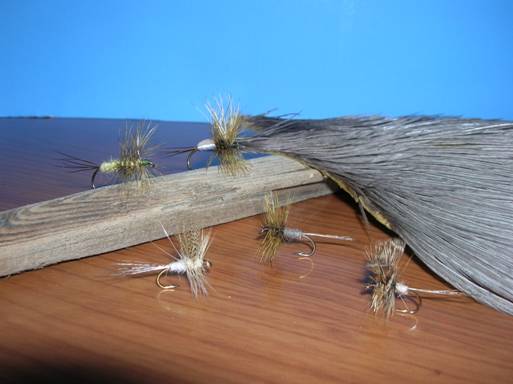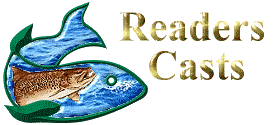THE HACKLED FLY

As a youth, my fly fishing world began with the generosity of an Uncle. I mentioned while sitting at the table with a group of family and friends after a day of trout fishing, that I really wanted to try fly fishing. I was speaking in terms of the local pond that was in walking distance of our house. The next weekend, my uncle arrived with a 7 ½’ Diawa fly rod, adorned with a Pflueger Medalist reel and intermediate line. The line had a metal loop inserted into it for leader attachment. My uncle bait fished, and he had been drifting worms with a fly rod since I had known him. The rod was an old backup in which he felt able to part with. It was a generosity that did not go unnoticed even to a 12yr old kid from Rural Pennsylvania.
The following summers became a world involving 2 things both of which were equally challenging to my young hands. They were, learning to cast along a farm pond bank without catching my back cast in the Sumac, and bailing enough hay locally to afford keeping myself stocked with panfish poppers & the wet flies on the bait shop pegboard. At $1.00 an hour, those flies came at a premium of sweat and time off of fishing on a sunny Saturday. The choices were slim at the local shop. There were the classic variety of Gaines poppers & a variety of wet flies on cards which included McGinty Bee’s, Royal & Lead-wing Coachmen, Parmachene Belles, Pink Ladies and Black Gnats. I would search through the wet fly cards hanging there and greedily dole out my hard earned dollars. All I knew was that bluegills and red-eared sunfish loved them! Many a time I recall rolling up my pants to wade out in the shallow water in order to rescue my last fly from the grips of a cattail or lilly pad. No price was too high for the bounce of a bluegill on a small glass rod, and the prize of bluegill fillets dredged in seasoned breadcrumbs.
For trout however, it was relegated to a 4’ piece of 2lb mono tippet tied to that metal ring, and a #10 bait holder hook. The thought of trout fishing really only seemed to involve dry flies back then, and my line did not float. That simple fact relegated me to a life of bait fishing for trout with a fly rod and wax worms. I would stand and watch as the hatches came off along the local streams and wonder at the fishermen casting dry flies toward those surface rings.
Soon after however came cars, graduation, and a military enlistment and left behind were that rod and reel to the family lineup of gear. My fishing for a number of years after involved spinning gear and catching time on waters wherever I happened to find myself able. I enjoy fishing, regardless of the format though, so I never felt short-changed. However, one day in Lacey Washington brought the world of fly fishing back to the forefront. Each day on the way to work I passed a small fly shop. And eventually curiosity got the best of me and in I strolled. It was a classic small fly shop, owned by a retired Army Captain and his son. George, the owner was a welcoming person to talk with & that trait kept me there for countless hours with me asking questions as he sat at his desk and tied. It only took a few visits and I was enrolling in a tying class, with the goal of acquiring a hobby that I could also take with me on military deployments. Well, that hobby caught on which grew to rods and reels and inevitably dry flies.
That tying class inspired that amazement once again that I had as a boy, watching those gentlemen casting dry flies along Fishing Creek in Central Pennsylvania. I was drawn to dry flies by their visible elegance of course, but even more so to the materials that were involved in their creation. I am an addict of hackle. I admittedly will pass on a productive pattern using synthetics, in order to tie a similar pattern using natural hackle. I can sit and sort through walls and walls of dry fly necks, tailing materials, and winging hackle for hours. Never growing bored or feeling that time is wasting. The Catskill patterns of old, as well as the modern stand-by all fascinate me. I often wonder at whether or not it is the fish’s rise and take of a dry fly, the beauty of the natural itself fluttering from the surface of the water, or the art of tying the fly that so deeply has its hooks into my skin? But regardless of which is the higher power, it has relegated me to a helpless dry fly romantic. It is the reason that I grow bored of tying nymphs and other styles of tying at some point, and always find a way to tie a new or favorite dry fly after a short sit at the bench. It’s also why at times I will leave all other patterns at home in an effort to spend some “quality time” with my dry fly boxes.
It influences my rod selection, line selection, favorite hatches, my gear choices and most of my fly fishing pursuits. It even affects my choice of tying vice for my bench. All of it, coming full circle to my love affair with the hackled dry fly. It’s the stance of a perfectly selected Cree hackle collar on its tips, or the minute elegance of a size #20 Blue-winged Olive dry in the vice. It’s the dance of a Catskill search pattern on the surface as it rides a riffle or the perfection as a size #16 Pale Morning Dun lights on the surface at the end of a 7X tippet on skinny water. I am drawn by the materials that make all of those things happen. From the feel of a new genetic neck and a perfect selection of wood duck flanks, to the selection of tailing hackles from a dry cape or the search for the treasure of a sought after Coq-De-Leon saddle. Each aspect in its own brings me full circle to my love affair with the hackled dry fly, the anticipation of the next hatch and the next water visited. When all things will come together the nose will turn on my fly in a telltale swirl and the lifting of the rod will place that all familiar bend in the rod.
